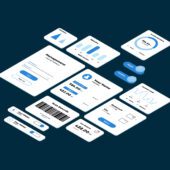When businesses implement high-end systems, they need to work with enterprise application development firms to get the most out of the enhanced features and functionality. As a business owner, you may use enterprise apps to automate critical processes, improve productivity, increase Efficiency, and yield a high rate of return over time. The main justifications and advantages for selecting enterprise application development are listed below.
Enterprise Application Development: What Is It?
An enterprise application development is a straightforward yet crucial technology that, unlike other software solutions, serves the entire corporate organization rather than just one department. It allows the company’s systems to communicate and function as a single unit, facilitating the firm’s workflow and establishing an open and obvious channel of communication between the company’s departments.
Popular locations that can provide this service include:
- Accounting and Billing Systems
- Customer Relationship Management (CRM)
- Point-of-Sale Software (POS)
- Supply Chain Management (SCM)
- Enterprise Resource Planning (ERP)
- Business Intelligence Systems
- Human Resource (HR) Systems
Enterprise Application Development Significance to a Business
A centralized system running several systems at once is known as enterprise software. One could argue that enterprise software functions similarly to a troubleshooter, addressing each business concern individually. It is a very user-friendly system that can streamline many aspects of business administration, including payroll, IT, finance, and resources. Given the nature of the modern business environment, it has been demonstrated that enterprise software is necessary, even for small and medium-sized enterprises. Enterprise apps can automate system procedures and provide reliable, precise forecasts, boosting your company’s productivity.
Companies could question why they should use a different business to create an enterprise application. Many firms believe you may run the application independently by using the instructions on the official website. The optimal variety of alternatives is crucial while searching for the ideal business application. Getting advice from a business that specializes in software applications and is competent, skilled, and experienced is a smart idea. Companies will be able to focus more on their main business tasks and save significant time as a result. A top-notch IT infrastructure at the enterprise level allows you to attain knowledge availability and transparency across all business operations.
The Benefits of Enterprise Application Development
- Enterprise Application Development Business Process,
- Easier Enterprise Resource Planning and Reporting,
- Automates Business Workflow,
- Higher Efficiency,
- Enterprise Software Offers More Secure & Qualitative Data,
- Higher Scalability and Enterprise Application Integration,
- Better Customer Relationship Management Service.
The Drawbacks Regarding ERP?
- The ERP’s Cost,
- The Difficulty and Training Needs
- Not Investing in a Customized System,
- Personalization.
Six Steps for Enterprise Application Development
Collecting Requirements
The first step in this process is gathering and recording specific requirements for enterprise application development. This entails being aware of the product’s functional requirements, user needs, and business goals. The software development team engages in stakeholder interactions, interviews, and analysis to establish the project’s scope, essential features, and requirements.
Organizing and Coordination
During this phase, a thorough project plan includes the development strategy, schedules, resource allocation, and milestones. The plan ensures the project’s goals, stakeholders, and development team are all in sync. It entails creating routes for communication, outlining roles and duties, and determining possible hazards and ways to mitigate them.
Design of UI/UX
The UI/UX design stage aims to give the corporate software an easy-to-use interface. Designers create wireframes, prototypes, and visual designs to meet user expectations and requirements. In addition, the UI/UX design takes branding, usability, and accessibility into account to provide a visually pleasing user experience.
Program Development
Corporate software has been developed at this level. Code is written by developers, who also integrate modules and other required parts. They also put the intended features and functionalities into practice—a process for developing enterprise applications.
Execution & Distribution
Extensive testing is carried out after development is finished to guarantee the software’s functionality, Efficiency, and dependability. Moreover, it encompasses a range of testing methodologies, including system, user acceptability, integration, and unit testing (UAT).
Upkeep and Assistance for the Development of Enterprise Applications
Corporate software needs continuous support and maintenance after it is deployed. This entails fixing faults or issues that have been reported and issuing updates and fixes, thus offering end users technical support.
The Obstacles to Enterprise Application Development
outdated programs and systems
High costs and technical debt result from legacy systems’ incompatibility with new technology, expensive maintenance, and altered business procedures.
Lack of resources and talent
The need for developers has made attracting and retaining talent more challenging. Enterprises cannot remain competitive if they cannot deliver apps quickly enough or with enough resources.
Adapting to Agile presents challenges.
Agile provides greater insight into the app development process, whereas traditional methods result in higher expenses, poorer app quality, and production delays.
Communication gaps between business and IT
When developing apps, clear communication is essential, but departments operating in silos and changing requirements frequently lead to subpar products.
Handling evolving specifications
Revisions to the project scope made during development frequently cause delivery delays and cost overruns. To maintain software development within time and money restrictions, project managers must assess and rank change requests.
Addressing issues related to security
Using mobile devices to access confidential company data raises security risks such as data loss, compromise, and corruption. When creating an enterprise application, authentication and authorization controls must be considered.
Switching to a mobile device
In a work-from-anywhere setting, enabling data and service-sharing tools is critical. The goal for developers should be to create applications that are as easy to use on mobile devices as they are on desktop and laptop computers.
Keeping information safe
Almost all employees in an organization expect to be able to access data quickly and effectively. Selecting the best cloud platform for your company’s requirements can help guarantee quick and reliable access for authorized users.
Guaranteeing Compatibility
The secret to a successful project is determining which software is required for daily operations and developing an enterprise application that interfaces with that software. Workers prefer to simplify their tools rather than have to pick up new ones.
Establishing the optimal user experience
Providing an effective, user-friendly interface that makes enterprise software important to the company could take a few tries.
Calculating the ROI or return on investment
Establishing key performance indicators aids in gauging the corporate application’s worth for stakeholders.
Comparing Modern and Traditional Enterprise Application Development
Conventional Apps Development
Slow app development
The creation of an app requires much time.
OS dependent
Migration and scalability are complicated by the operating system and application’s dependence on one another.
App updates are released slowly because much effort goes into identifying the cause and a solution to issues.
Organizational structure comes first. Before releasing the application code, developers give it to the operations team.
Expensive
Setting up data storage and other needless services is the responsibility of the app development team.
Not secure
The organization’s server hosts development over the whole life cycle.
Modern App Development
Quick app development
Programmers adhere to a structure intended to optimize adaptability.
OS independent
Developers use the development platform to get rid of dependencies. Scalability and migration are simple.
Updates to the software are released more quickly, which helps the business better satisfy customer needs and retain more users.
Quick and seamless transition
The development process integrates people, procedures, and tools using a distinct strategy.
Economical
A company has to pay for the equipment it needs.
Extremely secure
Cloud-based data is safe. It is simple to use and accessible from anywhere in the world.
Conclusion
In conclusion,
Whether it’s increasing Efficiency, fostering better teamwork, or strengthening customer service. Enterprise application development is now essential for major firms to stay competitive and continue to advance.







A Complete Guide Of Software Product Development: Best 4 Types - Microdeft
[…] enterprise software development approaches are available today, each with benefits ranging from reduced risk to increased […]